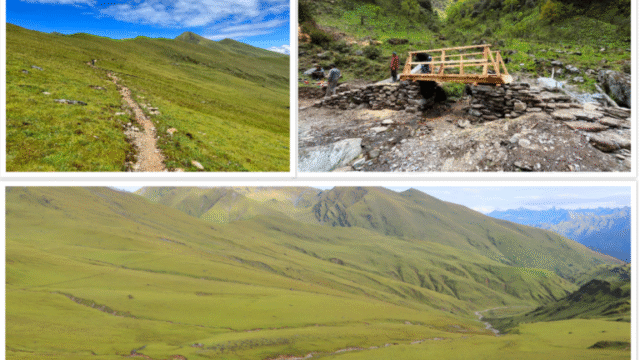The newly inaugurated Mundhum Trail, beginning at Tawa Bhanjyang in Sakela Rural Municipality-3, Khidima, is gaining popularity as a premier trekking destination in Nepal’s Khotang district. Stretching approximately 107 kilometers, this trail ranks among the Nepal Government’s top 100 tourist destinations.
Significant investment from all three levels of government has contributed to the development of the Mundhum Trail, enhancing its appeal for nature lovers, adventure enthusiasts, and researchers of Kirati culture. This scenic trail offers travelers an opportunity to experience the unique traditions and beauty of Kirat culture while immersed in stunning natural landscapes.
As autumn begins, tourists, including residents from Kathmandu and nearby cities, flock to Mundhum Trail to explore and study its beauty. Laxman Rai, a shepherd from Kapilashgadhi Rural Municipality-1, shared, “Once October starts, groups of tourists arrive frequently. However, there aren’t enough places to accommodate them, so we offer shelter in sheepfolds and yak herding sites. The government needs to support this growing destination to create more facilities. Promoting Mundhum Trail can greatly benefit both the local economy and the country.”
Nestled among the eastern hills of Khotang, Bhojpur, Solukhumbu, and Sankhuwasabha, the Mundhum Trail holds historical significance to the Kirat community. Developed by the Maiyung-Temke-Salpa Silichung Tourism Promotion Center, the trail starts at Tawa Bhanjyang on the Khotang-Bhojpur border, passes through 3,165-meter-high Temke Danda, 3,750-meter-high Salpa Pokhari, and concludes at Silichung at an elevation of 4,165 meters. The trek takes about 13 days for foreigners and 10 days for locals to complete.
A key attraction is the scenic views of towering Himalayan peaks, including Mount Everest, Kanchenjunga, Makalu, and Lhotse. Additionally, trekkers can experience the cultural richness of Kirat villages along the route. With infrastructure work approximately 65% complete, the trail promises modern facilities and offers traditional homestays where visitors can experience local foods such as churpi, dhido, local chicken, and vegetables.
Wildlife such as the red panda, honeybees, and various bird species, along with rhododendrons and medicinal herbs, add to the natural allure of Mundhum Trail. The Swiss government’s involvement has further boosted development, and Swiss Ambassador Elisabeth von Capeller’s visit to Khidima on April 13, 2021, highlighted the international interest in promoting this trail as a sustainable tourist destination.
In addition to ecological and cultural significance, the Mundhum Trail fosters economic development by attracting both domestic and international tourists. Community members now support tourism through ‘Goth Stays,’ offering accommodations in renovated herding huts, and have expressed commitment to further improving the trail’s infrastructure and facilities.
Source: RSS






